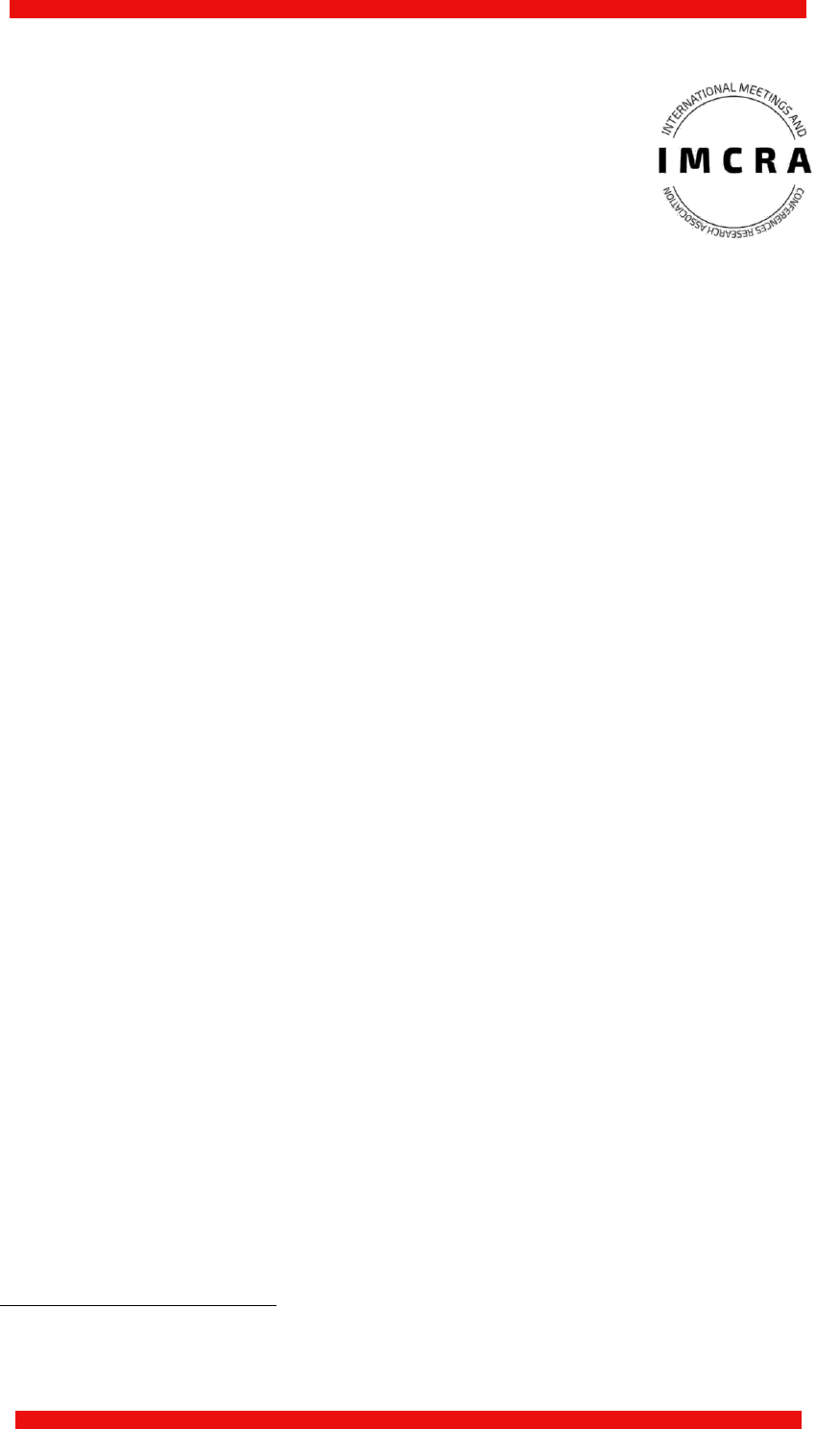
Science, Education and Innovations in the context of modern problems. Vol. 5. 2022, Issue 3, Abaci K.
p. 75 IMCRA, June, Baku, Azerbaijan
EFFICIENCY OF ELECTRONIC DOCUMENT
MANAGEMENT SYSTEMS: A CASE
STUDY
1
Kenan Abacı, Near East University, Graduate School of Social
Sciences, Turkey, [email protected]m
Ihsan Tolga Medeni, Yildirim Beyazit University, Faculty of
Business, Department of Management Information System,
Turkey, tolgamed[email protected]
ABSTRACT
The research was designed to 'present a good practice example' for other organisations that plan to use
Electronic Document Management System (EDMS) in the future. The purpose of this study is to
investigate how effective the EDMS is in terms of managerial control, efficiency, job satisfaction,
efficiency and safety. The research model is a descriptive and cross-sectional study. The study population
consists of employees working in the central and provincial offices of the Ministry of Science, Industry
and Technology in Turkey. Questionnaires were submitted to 3248 people via Google Drive, and 880
responses were received. The questionnaire consisted of 42 questions in total 10 personal information
questions. For data analysis, descriptive statistical values, such as frequency, percentage, mean,
minimum, maximum and standard error are used. When the obstacles to EDMS applications were
reviewed, it can be seen that “technical infrastructure deficiency” the first place. The most important
expectations of the participants from EDMS applications are improved service (40.9%) and quality and
rich information communication (26.2%). Results indicated that the EDMS applications had positive
effects on job satisfaction and effectiveness. Administrative control, productivity, job satisfaction,
efficiency and security perceptions affect each other positively. Indicates that all sub-dimensions are
influencing each other positively.
Keywords: Public officers; job satisfaction; efficiency; productivity; safety
1. Introduction
The United States Bureau of Efficiency was established in 1913 to resolve unmanageable number of
documentation problems. With the initialization, the first efforts were made to save crucial resourses in
terms of monetary value in the governmental expenditures (Penn, Pennix and Gow, 1994). Along with
these efforts, the mindset claiming control of document production as a necessity began to become
widespread. Developments in recording, storing and copying technology, which are shown as the most
important reasons for the increase in document production, have led to the adoption of that mindset. In
1934, the National Archives of United States was established. This led to the idea that documents have
a 'life cycle' that expresses life process as a feature of archiving and hiding from birth to death and
having access when it is needed, just as living things. This concept is an important building block
playing a role in the formation of modern document management (Hare and McLeod, 2006).
With advances in computer and communication technologies, the use of e-business applications in
public institutions has become rapidly widespread. This in turn brought the need for the development
1
1
Received: FEB 08, 2022/ Accepted: 24 MAR, 2022, Published 19MAY, 2022

Science, Education and Innovations in the context of modern problems. Vol. 5. 2022, Issue 3, Abaci K.
p. 76 IMCRA, June, Baku, Azerbaijan
of various standards for the production and use of electronic documents. This need has been recognized
especially by developed countries since 2000 and various standardization studies have been initiated.
Information is the fuel that drives government programmes and services (Munge at al., 2014). At the
beginning of the 21 st century, administrative procedures have slowed down, document access has
become difficult and storage troubles have arisen because of the increase in document production and
the financial losses caused by this increase, and the lack of work on sufficient regulations to winnow
out and dispose of redundant documents. Public sector organizations throughout the world are
increasingly adopting Information and Communication Technologies (ICTs) based systems to improve
information management and service delivery. However, it is a big challenge to implement information
systems in the public sector because technology adoption and use depends on multiple factors. For
instance, overall technology adoption at both the institutional and individual levels may be influenced
by the characteristics of the area in which the information system is implemented (Mosweu, Joseph and
Mutshewa, 2017). These developments have been such that the current century is arguably epitomized
by a knowledge-based economy, where knowledge, information and ideas are the main source of
economic growth. Due to this and other social and technological changes, such as advances and
developments in computer and communication technologies, ongoing globalization, increased
deregulation and so on, new patterns of work and business practices are being developed (Jawad, Peter,
Donald, and Yusra, 2018).
In institutions and organizations, information and document resources are widely used as tools for
decision support, business process management, structured communication, auditing and verification.
The effective management of these resources also plays a key role in improving corporate success.
Public institutions and organizations must produce and accept documents, then store and reuse those
that are evidence of their actions to carry out activities, perform management actions and fulfill their
legal obligations (Gülenç, 2016).
If electronic document management systems (EDMS) were used in public institutions, those public
institutions would take advantage of great benefits. In addition to the cost, labor force, time and space
advantages, those systems also offer benefits of security and archiving for the institutions. Considering
the benefits for civil service, it can be claimed that working hours can be changed. Operations can be
performed during evening, lunch break or weekend shifts if necessary. If the process of distribution of
the documents and records by mailing them out was handled, another cost would be reduced. Even
more importantly, the correspondences would be exchanged directly. Reduced workload will offer the
advantage of efficiency in resource utilization. Unlike the previous filing systems, it would be possible
to access files or information more quickly. Electronic information and document management systems
provide institutions and organizations with the opportunity to use their stored information and
documents in an effective and efficient way.
1. LITERATURE
1.1. Electronic Document Management Systems
The basic idea behind the document management is to be able to give institutional memory to the
organization when it is needed to show evidence of the activities in the the format of relations, content
and documents (Arslan and Kaya, 2017). Many managers have become aware that efficient control of
information flow leads to effective management. Document Management (DM) is increasingly
recognized as one of the most reliable methods for managing an organization’s flow of information in
both the public and private sectors (Haitham, Raymond and Yukon, 2016).
Electronic documents refers to different types of documents that are created, stored, distributed and
disposed of on computers in conjunction with business activities within other electronic devices on
digital platforms (Singh and Sharma, 2009). Documents created by converting paper documents into
digital formats are also considered as electronic documents. However, they must be marked with a time
stamp indicating that these documents have not been changed, so that they can be seen as an original
electronic document converted from paper into a digital format (Kashem, Akhtar and Rahman, 2014).
1.2. The Impact of EDMS on Employees
The performance of public sector employees has become significant in ensuring productivity, and

Science, Education and Innovations in the context of modern problems. Vol. 5. 2022, Issue 3, Abaci K.
p. 77 IMCRA, June, Baku, Azerbaijan
technology is one of the most crucial factors in improving their performance. When employees can access
information and documents easily, their performances can be affected positively, leading to an overall
increase in productivity in the public sector (Kimbugwe, Lewis and James, 2009).
Job satisfaction and motivation levels among civil servants can also be increased by EDMS, which can
enable employees to work more efficiently, thus reducing their workload. Users of EDMS can also
keep themselves updated regarding the latest technological developments. Employees need to be aware
of new technology and use technology in business processes, which will reduce workloads by
increasing business productivity.
1.3. The Impact of EDMS on the Organisation
As new technologies have been emerged, organizations have moved from traditional EDMS to an
electronic form of EDMS since it facilitates the managerial work through file integration and control.
Based on the previous studies, an electronic EDMS provide many advantages including management
support, budgetary, Security, Cooperation, performance, privacy and Systems integration (Abdulkadhim,
Bahari, Bakri and Ismail, 2015).
Effective functioning in public institutions is an important aspect of ensuring the development of
the national economy. The more efficiently and effectively public institutions function, the more
powerful the national economy will become (Warner, 2016). In this regard, public institutions should
manage technology and information together for the efficient operation and updating of their systems,
using continuously developing technologies (Baird, Haynes, Massey and Wild, 2011).
EDMS allows public institutions to interact with different institutions and enterprises, thus ensuring the
rapid distribution of information. EDMS plays an important role in the flow of information between
public institutions and the private sector. Information requested by the private sector or the public is
quickly and easily shared via the EDMS system. Moving from a traditional paper work system to an
Electronic Document Management System helps educational institutions to reduce costs, automating
processes increased document security and minimizing errors.
One of the reasons for switching to EDMS is that institutions aim to reduce costs. Even though EDMS
initially requires investment costs, this is compensated for by reducing the cost of use (Kwatsha, 2010).
However, the software and hardware used by these systems need to be updated constantly, while
maintenance is also a factor causing additional costs. Errors and glitches that may occur in the EDMS
may cause the system to come to a full stop, requiring the services of experts to prevent or eliminate
such problems and resulting in additional costs. Employees should undergo a comprehensive training
programme to ensure that they can use the EDMS systems correctly and properly, and these trainings
would also involve additional costs (Öğüt, 2012).
Public institutions need to manage their knowledge database to strengthen their links with the outside
world and share their services. There are both direct and indirect benefits of investments made in these
types of systems. Direct benefits include increase in productivity and savings in manpower, reduction
in processing, plant, hardware (computer) and secretarial costs. Indirect benefits include improving
resource control, increased organisational flexibility, timely information access, job satisfaction,
beneficiary (customer) satisfaction and employee motivation (Özbay at al., 2014).
2. METHODOLOGY
2.1. Research objective
The purpose of this study was to investigate the adoption and use of electronic document management
system (EDMS) in the public service in Turkey with the aim of establishing barriers and enablers, and
best practices which each country could adopt from the other. It is hoped that the study will stimulate
further research interest and raise awareness in government departments with regard to EDMS policy
implementation, especially in the area of electronic content management. In addition, the research was
designed to 'present a good practice example' for other organisations in Turkey that plan to use EDMS in
the future.

Science, Education and Innovations in the context of modern problems. Vol. 5. 2022, Issue 3, Abaci K.
p. 78 IMCRA, June, Baku, Azerbaijan
2.2. Research Design and Hypotheses
The research models descriptive and cross-sectional and a questionnaire survey was used as the main data
collection tool.
The research hypotheses are as follows:
H
1
: EDMS ensures managerial control.
H
2
: EDMS ensures productivity of work.
H
3
: EDMS ensures job satisfaction.
H
4
: EDMS ensures efficiency.
H
5
: The personal information security of the employee's computer is safeguarded by using the EDMS.
2.3. Population and Sample
The universe of the workforce is composed of staff working in the central and provincial offices of the
Ministry of Science, Industry and Technology as of 09/12/2017. Number of staff working at the center;
1421 (43.75%) and the number of personnel working in the provinces; 1827 (56,25%), 3248 employees in
total. A total of 3248 questionnaire forms were sent and 880 (27.09%) forms were returned. The universe
is 3248. According to Sekaran and Bougie (2013), a sample size of 880 is suitable for a population of
3248. The questionnaire was applied between January and March 2018.
2.4. Data Collection Tool
The 42 questions about EDMS were constructed using a 5-point Likert-type scale consisting of 5
subscales: Managerial Control, Efficiency, Job Satisfaction, Productivity and Security. The questions
regarding the effects of EDMS applications on job satisfaction and efficiency were also designed using a
5-point Likert-type scale.
2.5. Data Analysis
Factor analysis and item analysis were conducted to test the reliability and validity. Cronbach's alpha
values of the sub-dimensions were also investigated. We used descriptive statistics, parametric or
nonparametric tests in the analysis of the data. The frequency, percentage, mean and standard deviation
were the descriptive statistics.
The question of whether tests would be parametric or nonparametric was solved based on the
Kolmogorov–Smirnov Test, to determine whether the sub-dimensions would meet normal distribution
conditions. Given that 'p' values were at the 5% significance level, the sub-dimensions did not meet
normal distribution conditions, indicating that parametric tests could not reveal statistically significant
results. Therefore, nonparametric tests, namely, Mann–Whitney U Test and Kruskal–Wallis H tests,
were applied. To determine which group was seen to have statistically significant differences at the 5%
significance level, the Bonferroni test was used.
3. RESULTS
The research results are presented in this section.
Table 1. Obstacles to EDMS Applications

Science, Education and Innovations in the context of modern problems. Vol. 5. 2022, Issue 3, Abaci K.
p. 79 IMCRA, June, Baku, Azerbaijan
Obstacles to EDMS
Applications
Minimum
Maximum
Mean
Standard
Deviation
Order of
Obstacle
Technical infrastructure
inadequacy
1
8
6,16
2,136
1
st
Inability to give up old
Abandonment of resident
bureaucratic habits
1
8
5,77
2,08
2
nd
Employing qualified
technical staff
1
8
5,76
2,205
3
rd
Security and hackers
problems
1
8
4,75
2,328
4
th
The pressure of higher
priority issues
1
8
4,36
2,123
5
th
Public administrators
should not look at the
EDMS system warmly
(lack of leadership
support)
1
8
4,09
2,401
6
th
Lack of legal regulations
1
8
3,96
2,115
7
th
Inability of appropriation
1
8
3,74
2,362
8
th
Table 1, when the questions are given to the participant, it was asked to score from 1 to 8 which is 1 is
representing minimum score and 8 is representing maximum score. Each participant scored the
questions based on their own perceptions. The higher the score, the more important it is for them.
When the obstacles to EDMS applications were reviewed, table 1 can be seen that “technical
infrastructure deficiency” the first place.
Table 2. Results of the Kolmogorov–Smirnov Test
Dimensions
The Mean
Standard
Deviation
Normal Distribution ‘Z’
P
Managerial Control
35,45
7,30
5,360
0,000
Productivity
70,42
16,21
3,371
0,000
Job Satisfaction
20,45
6,21
4,100
0,000
Efficiency
19,22
4,42
3,891
0,000

Science, Education and Innovations in the context of modern problems. Vol. 5. 2022, Issue 3, Abaci K.
p. 80 IMCRA, June, Baku, Azerbaijan
Security
12,40
3,59
2,708
0,000
Table 2, the Kolmogorov–Smirnov Test was used to test the normal distribution in the study.
According to the results of the Kolmogorov–Smirnov test, the sub-dimensions of managerial control,
productivity, job satisfaction, efficiency and security sub-dimensions failed to meet normal distribution
conditions (p < 0.05). In this case, the Mann–Whitney U Test and the Kruskal–Wallis H Test were
used as parametric or nonparametric tests.
The H
1
hypothesis was accepted in the study. When the mean value (35,45 ± 7,30) is examined, it is
seen that the majority of the participants are satisfied. With EDMS, activities such as control of work
processes, follow-up, employee supervision, controllability, workforce performance and decision
making are realized more effectively.
The H
2
hypothesis was accepted in the study. When the mean value (70,42 ± 16,21) is examined, it is
seen that the majority of the participants are satisfied. EMS shows that productivity is positive in terms
of productivity. With EDMS, time saving is provided, cooperation between personnel is increased,
documents are provided quickly, working is possible without time and space, and all transactions can
be recorded.
The H
3
hypothesis was accepted in the study. When the mean value (20,45 ± 6,21) is examined, it is
seen that the majority of the participants are satisfied. Personnel involved in the survey indicate that
EDMS applications create institutional memory, facilitate ease of use, allow for proper reporting, and
shorten signature processes. In addition, it is thought that information and documents are correct in
EDMS.
The H
4
hypothesis was accepted in the study. When the mean value (19.22 ± 4.42) is examined, it is
seen that the majority of the participants were satisfied. It can be said that EDMS applications
generally have positive effects on efficiency. Personnel involved in the survey indicate that EDMS
applications create institutional memory, facilitate ease of use, allow for proper reporting, and shorten
signature processes.
The H
5
hypothesis was rejected in the study. When the mean value (12,40 ± 3,59) is examined, it
shows that participants have negative attitudes towards safety in general. When the findings related to
security perception are examined in EDMS applications, participants have negative perception about
EDMS and electronic backups and document security.
Table 3. Mann–Whitney U Test for the Perception of EDMS Based on Gender
Dimensions
Gender
The Mean ± SD
Z
P
Managerial
Control
Female
37,336 ± 6,70
3,595
0,000
Male
34,97 ± 7,38
Productivity
Female
73,35 ± 13,68
1,932
0,053
Male
69,67 ± 16,72
Job
Satisfaction
Female
20,88 ± 6,86
1,537
0,124
Male
20,33 ± 6,04
Efficiency
Female
20,08 ± 3,58
1,937
0,053
Male
19,00 ± 4,58
Security
Female
13,10 ± 3,88
2,333
0,020
Male
12,23 ± 3,49
Table 3, when the perception of the EDMS based on gender was reviewed, there was no significant
difference in the scores for efficiency, job satisfaction and productivity sub-dimensions between
different gender groups (p > 0.05). However, there was a statistically significant difference in scores
for managerial control and efficiency (p < 0.05). In the managerial control (37.336 ± 6.70) and the
security (13.10 ± 3.88) sub-dimensions, women obtained higher scores of perception than men.

Science, Education and Innovations in the context of modern problems. Vol. 5. 2022, Issue 3, Abaci K.
p. 81 IMCRA, June, Baku, Azerbaijan
Table 4. Kruskal–Wallis H Test for the Perception of EDMS Based on Age
Dimensions
Age
The Mean ± SD
x
2
P
Managerial Control
25 and younger
32,60 ± 8,10
17,215
0,000
26–35
34,78 ± 7,67
34–45
35,08 ± 8,11
46–55
36,02 ± 4,82
56 and older
38,44 ± 5,98
Productivity
25 and younger
65,60 ± 14,39
20,578
0,000
26–35
69,11 ± 15,61
34–45
71,04 ± 16,29
46–55
72,83 ± 13,86
56 and older
73,49 ± 23,95
Job Satisfaction
25 and younger
17,09 ± 5,50
15,147
0,000
26–35
18,92 ± 6,16
34–45
20,99 ± 6,47
46–55
22,49 ± 4,37
56 and older
22,53 ± 7,87
Efficiency
25 and younger
16,54 ± 5,29
18,009
0,000
26–35
18,12 ± 5,26
34–45
19,79 ± 3,76
46–55
20,23 ± 3,11
56 and older
20,77 ± 4,64
Security
25 and younger
10,45 ± 3,01
20,835
0,000
26–35
11,77 ± 3,42
34–45
12,32 ± 3,82
46–55
12,62 ± 3,00
56 and older
13,84 ± 3,99
Table 4, when the perception of EDMS based on age is reviewed, we can see a significant difference
between age groups in terms of the managerial control, productivity, job satisfaction, efficiency and
safety sub-dimensions (p<0.05). According to the Bonferroni test results, the perception scores of
individuals from the age group of 25 and younger and those of individuals from the age group of 46
years and over differ in all the subscales. Younger individuals' perception scores for the EDMS in
managerial control, productivity, job satisfaction, efficiency and security are lower than those from the
older age groups.
Table 5. Kruskal–Wallis H Test for the Perception of EDMS Based on Educational Background
Dimensions
Educational
background
The Mean ± SD
x
2
P
Managerial Control
High-school
36,08 ± 6,67
1,159
0,763
Associate
35,66 ± 3,20
Bachelor's
35,44 ± 7,48
Master's
35,16 ± 8,76
PhD and higher
35,29 ± 1,95
Productivity
High-school
73,05 ± 13,63
4,995
0,172
Associate
73,49 ± 11,95
Bachelor's
70,43 ± 16,43
Master's
68,30 ± 17,93
PhD and higher
64,94 ± 16,72
Job Satisfaction
High-school
20,73 ± 5,85
6,226
0,092
Associate
22,22 ± 3,79
Bachelor's
20,37 ± 6,60
Master's
19,63 ± 6,19

Science, Education and Innovations in the context of modern problems. Vol. 5. 2022, Issue 3, Abaci K.
p. 82 IMCRA, June, Baku, Azerbaijan
PhD and higher
20,82 ± 3,02
Efficiency
High-school
19,18 ± 4,00
5,375
0,146
Associate
20,35 ± 2,93
Bachelor's
19,23 ± 4,56
Master's
18,70 ± 4,81
PhD and higher
18,29 ± 2,64
Security
High-school
11,71 ± 3,86
5,742
0,125
Associate
12,83 ± 2,35
Bachelor's
12,48 ± 3,68
Master's
12,38 ± 3,81
Ph.D and higher
10,64 ± 3,59
Table 5, when the perception of EDMS based on educational background was reviewed, we found no
significant difference between the groups with different educational backgrounds in the managerial
control, productivity, job satisfaction, efficiency and security sub-dimensions (p>0.05). The scores for
the EDMS perception of the employees did not vary by educational background.
Table 6. Kruskal–Wallis H Test for the Perception of EDMS Based on The Department of Graduation
Dimensions
The Department of
Graduation
The Mean ± SD
x
2
P
Managerial Control
Natural-Physical Sciences
36,12 ± 6,12
3,694
0,158
Engineering
35,68 ± 3,63
Social Sciences-Law
35,72 ± 7,85
Others
35,35 ± 8,71
Productivity
Natural-Physical Sciences
72,52 ± 11,22
2,963
0,227
Engineering
70,48 ± 16,52
Social Sciences-Law
68,27 ± 17,82
Others
68,52 ± 16,93
Job Satisfaction
Natural-Physical Sciences
22,18 ± 3,63
2,705
0,259
Engineering
20,42 ± 6,72
Social Sciences-Law
19,58 ± 6,22
Others
21,92 ± 3,82
Efficiency
Natural-Physical Sciences
20,22 ± 2,92
3,074
0,215
Engineering
19,58 ± 4,45
Social Sciences-Law
18,96 ± 4,85
Others
18,52 ± 2,14
Security
Natural-Physical Sciences
11,85 ± 2,62
4,400
0,111
Engineering
11,27 ± 3,52
Social Sciences-Law
12,42 ± 3,73
Others
10,81 ± 3,14
Table 6, when the perception of EDMS based on the department of graduation degree was reviewed,
we found no significant difference between the groups graduated from different departments in the
managerial control, productivity, job satisfaction, efficiency and security sub-dimensions (p>0.05). The
scores for EDMS perception of the employees did not vary by the department of graduation degree. It
is thought that the perception of the EDMS may vary depending on the educational situation, as the
tendency of individuals to access information and to use the information effectively increases as the
educational status of the individuals increases. However, when the results are analyzed, it is
determined that the EDMS perception does not vary according to the educational status.
Table 7. Kruskal–Wallis H Test for the Perception of EDMS Based on the Number of Years Worked in
Organisation

Science, Education and Innovations in the context of modern problems. Vol. 5. 2022, Issue 3, Abaci K.
p. 83 IMCRA, June, Baku, Azerbaijan
Dimensions
Number of Years
Worked in Organization
The Mean ± SD
x
2
P
Managerial Control
Less than 5 years
32,59 ± 8,12
20,521
0,000
6–10 years
34,77 ± 7,58
11–15 years
36,08 ± 8,22
16–20 years
36,21 ± 8,82
21–25 years
37,52 ± 6,51
More than 26 years
38,42 ± 6,84
Productivity
Less than 5 years
65,68 ± 8,63
22,563
0,000
6–10 years
66,52 ± 8,51
11–15 years
67,39 ± 5,74
16–20 years
70,52 ± 8,32
21–25 years
71,84 ± 7,63
More than 26 years
72,20 ± 8,23
Job Satisfaction
Less than 5 years
17,20 ± 3,68
21,583
0,000
6–10 years
18,81 ± 4,52
11–15 years
20,98 ± 5,21
16–20 years
21,15 ± 6,27
21–25 years
21,62 ± 8,41
More than 26 years
22,84 ± 6,18
Efficiency
Less than 5 years
16,55 ± 6,24
23,541
0,000
6–10 years
18,12 ± 5,61
11–15 years
19,77 ± 3,52
16–20 years
20,28 ± 3,54
21–25 years
20,77 ± 6,52
More than 26 years
21,79 ± 4,31
Security
Less than 5 years
10,43 ± 2,52
23,621
0,000
6–10 years
11,72 ± 3,41
11–15 years
12,38 ± 2,69
16–20 years
12,39 ± 5,21
21–25 years
12,85 ± 6,52
More than 26 years
13,80 ± 8,12
Table 7, when the perception of EDMS based on the number of years worked in organisation was
reviewed, we find a significant difference between the groups which worked for different number of
years worked in the organization in the managerial control, productivity, job satisfaction, efficiency
and security sub-dimensions (p<0.05). According to the Bonferroni test results, in all sub-dimensions,
the perception scores of individuals who worked in the organization for less than 5 years were different
from those of individuals who worked in the organization for 21 years and over. Those who worked in
the organization for a short time have lower scores of EDMS perception than those who worked in the
organization for a long time in the managerial control, productivity, job satisfaction, efficiency and
security sub-dimensions.
4. CONCLUSIONS
With the current rapid developments in the domain of information technology, the document
management processes have been moved into digitized realm. From the system perspective, this
digitized realm is called as the Electronic Document Management System (EDMS). Information is
crucial for the decision making, for this reason it is necessary to quickly and accurately reach to this
organizational asset. With respect to this context, it is important to determine how the changes in the
lifecycle of the document are effect the perception of the users in terms of EDMS. Therefore, a case
study was conducted in the MSIT.

Science, Education and Innovations in the context of modern problems. Vol. 5. 2022, Issue 3, Abaci K.
p. 84 IMCRA, June, Baku, Azerbaijan
In this study, the expectations from EDMS applications in the MSIT, the obstacles in EDMS
applications and the effects of EDMS applications on job satisfaction and productivity were
investigated. It is indicated that the most important expectation from the EDMS applications in the
organization was improved service. Civil servants also wanted quality and rich information
communication. When the services provided electronically in the MIST were reviewed, we found that
services offered for providing and giving information are at the forefront. When the obstacles to the
EDMS applications were reviewed, we found the lack of funds to be the most important obstacle, but
the lack of legal regulations was also considered an important obstacle. We can conclude that EDMS
applications played an important role in increasing efficiency, while also affecting the job satisfaction
of civil servants positively.
Desktop-based electronic document management system should be developed. Thus, the Java update
does not cause problems in e-signature. With directing the end users step by step, the system assures
stopping the problems before being created. The systems also log all the transactions and the user
activities with including the information of the users. In the process of written communication, control
and authentication rights is given to the hierarchical managers. All the digital footprints on the
documents also log to the able to give the ability of past activity monitoring. By these precautions, the
systems block the possibility of unauthorized document destructions. On the indicators of the
efficiency are the time usages. Time is the sole indicator that cannot be regained. Efficient
organizations are the ones which can use time well. This indicator is the one which the government
organization is mostly criticized about. The EDMS also helps administrators for efficient use of the
time.
As a constraint of this research, only a single EDMS and its effect on a government body was
investigated. For this reason, other EDMS structures and efficiency could not be included. However,
the main finding of this research is the efficiency of this system over traditional manual document
system. To be able to use EDMS, the government organizational should be register into the Registered
Electronic Mail (REM) system. Only the organization and government officers who have the e-
signature authentication can use the system. Based on the findings of this research, this system
increases the efficiency of the system security but not the efficiency of the usage time. The REM
mechanism only gives authentication to the upper managers, not the lower level officers who are the
real creator of the documents. This system increases efficiency of the security by giving all autheration
to the single point but also decreases time usage efficiency. By given recommendation of the system
users, by letting outside log-in mechanism would increase the system efficiency. Not only constant
trainings is required not just at the initialization stage but also in different time intervals. The users
lack-of system knowledge also decreases the efficiency of the systems. Help documents need to be
prepared for the end users to explain the stages of installation details.
Results revealed that the technological infrastructure and technical qualities are insufficient within the
scope of the EDMS applications. Thus, improving the technological infrastructure is important to
ensure the efficient operation of the system and the conduct of the necessary R & D activities. The
most appropriate system can be developed by working in coordination with other organizations and
countries advanced where EDMS software is developed and by considering the knowledge and skills of
the employees in the organization.
The document management system that covers many of elements among the basic values in an
organization is a management area that should be implemented through interdisciplinary cooperation.
For this reason, each element in the information and document management system should be
evaluated separately and then detailed proposals should be prepared for each of these elements.
Some of the mistakes in the use of EDMS are caused by the human factor. To avoid mistakes arising
from the personal preferences of employees, authorities should minimize the situations where personal
preferences can be made. To solve this, standard templates can be created at the system inputs.
Security is one of the most important concerns of employees regarding EDMS. Organizations with
similar administrative structures should be established to ensure information security. Responsibilities
for the destruction of permanently erased data in the electronic environment should be determined,
along with responsibilities for ensuring that information security would be shared among the units.
While planning the measures to be taken, they should also be evaluated along with the technical and
administrative aspects.

Science, Education and Innovations in the context of modern problems. Vol. 5. 2022, Issue 3, Abaci K.
p. 85 IMCRA, June, Baku, Azerbaijan
Distinguishing document management from the traditional understanding by revising the corporate
structure is essential, along with the reorganisation of relevant units. In the aforementioned units, a
knowledge manager specialist should be employed and this person must be able to work in
coordination with other related units in carrying out document management activities.
While investments are made to ensure information security in organizations, it is important to consider
user awareness. To overcome the legal weaknesses of information security, developing policies and
organizing awareness trainings on those policies should be considered. In-service training should be
organized to ensure that employees work in accordance with regulations in the EDMS applications.
The technical infrastructure of the institution should be reviewed and updated if needed. Document and
archival processes and workflows should be organized. Institutions should be knowledgeable in these
issues and take conscious steps to ensure good performance. When organizations use EDMS, they
generally focus on the operational benefits of EDMS and generally ignore the benefits of strategic
decision support. For this reason, they should also use EDMS to improve their decision support
capabilities.
REFERENCES
1. Abdulkadhim, H., Bahari, M., Bakri, A., & Ismail, W. (2015). A research framework of
electronic document management systems (Edms) implementation process in government.
Journal of Theoretical and Applied Information Technology, 81 (3), 420-431.
2. Arslan M.; Kaya T. (2017). A research on effıcıency of edms as an e-government practıse:
Nevşehır Hacı Bektaş Velı Unıversıty Edms Case, Suleyman Demirel University The Journal of
Faculty of Economics and Administrative Sciences, 22 (15), 1999-2019.
3. Aziz, A. A., Yusof, Z. M., Asma M., Jambari, D.I. (2018). Electronic document and records
management system implementation in malaysia: a preliminary study of issues embracing the
initiative. In International Conference on Information, Springer Profesyonel, 585-591.
4. Baird A., Haynes J., Massey F., Wild R. (2011). Public service output, input and productivity.
Economic &Labour Market Review, 5 (2), 64-87.
5. Björk, B. C. (2003). Electronic document management in construction–research issue and
results. ITcon, 8 (2003), 105-117.
6. Boateng, H.; Agyemang F. G. (2016). A qualitative insight into key determinants of knowledge
sharing in a public sector institution in Ghana. SAGE, 32 (1), 35-43.
7. Gülenç, M. (2016). Management information creation, management effectiveness and effect on
productivity (E-School Example). Dumlupınar Üniversitesi, Institute of Social Sciences.,Master
Thesis, Kütahya, 8-10.
8. Haitham, A., Raymond, C., Yukun B. (2016), İnvestigating the critical success factors for
implementing electronic document management systems in governments: evidence from jordan.
Information Systems Management, 33 (4), 287-301.
9. Hare, C.; McLeod J. (2006). How to Manage Records in the e-Environment. London: Aslib.
10. Jawad S., Peter A. M., Donald H., Yusra M. (2018). Managing knowledge in the twenty-first
century. The Palgrave Handbook Of Knowledge Management. Switzerland, Springer
International Publishing AG.
11. Kashem, M. A., Akhtar, N., Rahman, A. (2014). An information system model for e-government
of digital Bangladesh. International Journal of Computer Science and Network Security, 14
(11), 62-69.
12. Katuu, S. (2012). Enterprise Content Management (ECM) implementation in South Africa.
Records Management Journal, 22 (1), 37-56.
13. Katuu, S. (2015). Managing records in South African public health care institutions: a critical
analysis. Phd thesis, University of South Africa.
14. Katuu, S. (2016). Managing digital records in a global environment: an assessment of the
landscape of international standards and best practice guidelines. The Electronic Library, 34 (5),
869-894.
15. Kimbugwe, K., Lewis, R., James, N. (2009). Labour inputs in public sector productivity:
methods, issues and data. Economic & Labour Market Review. 3 (4), 52-59.
16. Kul, H. R. (2009), Basics and applications of information systems for operators. İstanbul: Daisy
Publishing House
17. Kwatsha, N. (2010). Factors affecting the implementation of an electronic document and records
management system. Master Thesis, University of Stellenbosch.

Science, Education and Innovations in the context of modern problems. Vol. 5. 2022, Issue 3, Abaci K.
p. 86 IMCRA, June, Baku, Azerbaijan
18. Mahmood, A. Okumuş I. T. (2017). Design and implementation of electronic document
management system. Journal of Applied Sciences of Mehmet Akif Ersoy University, 1 (1), 9-17.
19. Manikas, K. (2015). Records management and electronic records management: opportunities
and limitations. a case study in Greek companies. Master Thesis, Linnaeus University.
20. Mosweu O., Joseph K.B., Mutshewa A. (2017). A probe into the factors for adoption and usage
of electronic document and records management systems in the Botswana context. SAGE, 33
(1), 97-110.
21. Munge, E., Rotich, D. C., Wamukoya, J. (2014). Archives & information science. African
Journal of Library, 24 (1), 15-26.
22. National Archives of Australia (2004). Digital recordkeeping Guidelines for creating, managing
and preserving digital records. [Online]. Retrievedfrom
https://mayaarbinaginting.weebly.com/uploads/1/0/6/1/10612501/digital_recordkeeping.pdf
[Accessed 4 October 2018].
23. Owens, K. (1996). İnformation management standards and practices division. Canada: Managing
audio-visual records in the Government of Canada
24. Öğüt, A. (2012). Management in the age of information. Ankara: Nobel book.
25. Özbay, T., Güçlü, A. N., Alır, G., Medeni, T. D., Öztopçu, L., Medeni, T., Bora, S. (2014).
Electronic document management (edms) integrated impact assessment: determination of a
method in the public sector and the first results of the field study. 12th International Conference
On Knowledge, Economy & Management Proceedings, 451-464.
26. Penn, I. A., Pennix, G. B., Gow, K. F. (1994). Records Management Handbook. Hampshire:
Gower.
27. Public Record Office (2002). Requirements for Electronic Records Management systems, Part 3:
Metadata Standard,2002 revision, final version, Kew, Public Record Office.
http://www.nationalarchives.gov.uk/documents/referencefinal.pdf [Accessed 5 October 2018].
28. Sekaran, U.; Bougie, R., 2013, Research methods for business: A skill-building Approach,
Wiley, New York.
29. Singh, A. K.; Sharma, V. (2009). e-Governance And E-Government: A Study Of Some
Inıtıatıves International Journal Of ebusiness And Egovernment Studies, 1 (1), 1-14.
30. The United States Department of Defense (2002) Design criteria standard for electronic records
management software applicaitons (Report No: DoD 5015.2-STD). Retrievedfrom
http://www.interpares.org/display_file.cfm?doc=dod_50152.pdf [Accessed 7 October 2018].
31. Warner, L. M. (2016). Productivity and management in public sector. Springer International
Publishing, 4 (5), 1-5.
32. Yazıcıoğlu, Y.; Erdoğan, S. (2004.) Spss Applied Scientific Research Methods. Ankara: Detail
Publishing.
